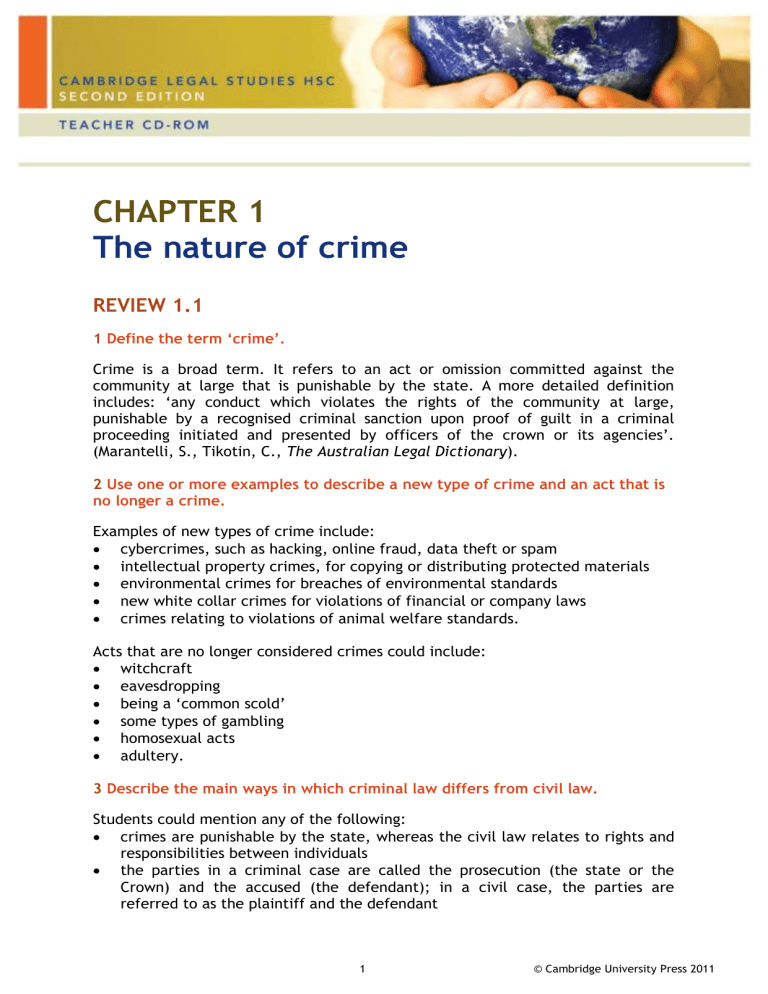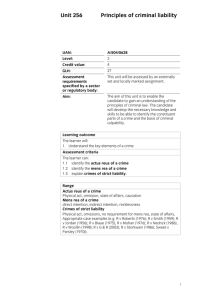hsc_legal_response01

CHAPTER 1
The nature of crime
REVIEW 1.1
1 Define the term ‘crime’.
Crime is a broad term. It refers to an act or omission committed against the community at large that is punishable by the state. A more detailed definition includes: ‘any conduct which violates the rights of the community at large, punishable by a recognised criminal sanction upon proof of guilt in a criminal proceeding initiated and presented by officers of the crown or its agencies’.
(Marantelli, S., Tikotin, C., The Australian Legal Dictionary).
2 Use one or more examples to describe a new type of crime and an act that is no longer a crime.
Examples of new types of crime include:
cybercrimes, such as hacking, online fraud, data theft or spam
intellectual property crimes, for copying or distributing protected materials
environmental crimes for breaches of environmental standards
new white collar crimes for violations of financial or company laws
crimes relating to violations of animal welfare standards.
Acts that are no longer considered crimes could include:
witchcraft
eavesdropping
being a ‘common scold’
some types of gambling
homosexual acts
adultery.
3 Describe the main ways in which criminal law differs from civil law.
Students could mention any of the following:
crimes are punishable by the state, whereas the civil law relates to rights and responsibilities between individuals
the parties in a criminal case are called the prosecution (the state or the
Crown) and the accused (the defendant); in a civil case, the parties are referred to as the plaintiff and the defendant
1 © Cambridge University Press 2011
the criminal standard of proof is beyond reasonable doubt; the civil standard is on the balance of probabilities
in criminal law, the burden of proof rests with the prosecution; in civil law, it rests with the plaintiff
the aim of criminal law is to protect the community and to provide a sanction or punishment to the offender if he or she is found guilty in court
in civil law, the aim is to address the defendant’s wrong by way of a remedy
(e.g. monetary compensation or a court order in favour of the plaintiff)
in criminal law, the offender faces investigation by the police and prosecution, and the case is heard in the criminal courts, which may result in conviction and punishment of the accused
in civil law, the case will be heard in a civil court and the plaintiff must establish the case against the defendant; if the case is proved, the court may then award some remedy in favour of the plaintiff.
2 © Cambridge University Press 2011
REVIEW 1.2
1 Explain the difference between actus reus and mens rea .
Actus reus refers to the physical act of carrying out a crime, whereas mens rea refers to the accused’s state of mind and level of intention to commit the physical act.
2 Using a specific crime as an example (e.g. drink-driving offence, murder, robbery), describe what you think the actus reus and mens rea of the crime might be.
Students can select any crime providing they can distinguish the physical element from the mental element. For example, assault would require the actus reus as the physical act, the accused actually kicking another person, but the mens rea would require that they did so with some degree of intention, not, for example, if the accused had accidentally tripped up or was having some form of involuntary convulsion at the time.
3 Describe how strict liability offences differ from usual offences and give examples of some strict liability offences.
Strict liability offences differ from ordinary offences in that they do not require the mens rea to be proved, only the physical actus reus. For example, it is an offence to sell tobacco to a minor. The act of selling to a minor is all that is required. It does matter that the offender did not know that the person was under
18 or did not intend to sell to them. Other examples include speeding offences or other traffic violations.
3 © Cambridge University Press 2011
REVIEW 1.3
1 Using offences as examples, describe some of the differences between offences against the person and economic offences. What types of crime do they include? What are the main effects of the crimes? Why do you think these acts are deemed ‘criminal’?
Some possible responses are included in the table below.
Category Examples Effects Reasons offences against the person homicide, assault, sexual assault physical and emotional harm to a victim; emotional harm to a victim’s friends and family; financial costs to a victim (e.g. recovery or hospital) to deter crime; to prevent the effects; to ensure the public’s physical safety; to provide a means to punish the offender economic offences property offences, white-collar crime, computer offences depriving another person of property; interfering with another person’s property rights; financial and emotional harm to a victim; harm to a business or shareholders of a company to deter crime; to prevent the effects; to ensure people’s property rights are protected; to provide a means to punish the offender
2 A number of driving offences and regulatory offences are strict liability offences. Using examples, describe why you think these crimes are strict liability only. What are the advantages and disadvantages for society of such offences being strict liability?
Some advantages of strict liability offences include:
faster prosecution
less costly for the state to prosecute
administrative benefits for high-volume offences, like traffic violations
strong deterrent against violations
lessens risk of insincere objections or appeals
less burden on police time and resources to pursue violations.
Some disadvantages of strict liability offences include:
removes rights in the criminal process
risks unfair prosecution where there was honestly no intention
makes it very difficult to appeal
risk of over-use or abuse by enforcers.
4 © Cambridge University Press 2011
3 Attempts and conspiracies often carry penalties as high as if the crime was actually committed. Evaluate why this might be and describe some of the possible difficulties in prosecuting an attempt or conspiracy.
Attempts or conspiracies carry penalties equally as high as the committed crime because they are punished as seriously as if the attempt or plan had not been foiled or prevented by police. This can act as a deterrent, but also recognises the seriousness of the crime that was attempted, and ensures police can prosecute without having to wait for the final act to be carried out — for example, before the trigger is pulled.
Attempts and conspiracies can be difficult to prove because it needs to be shown beyond reasonable doubt that the accused was prepared to commit the act and intended to do so. It may be required to show a higher level of intent than if the act had actually been carried out, to avoid prosecuting individuals for crimes they would never have actually committed.
5 © Cambridge University Press 2011
REVIEW 1.4
1 Describe the key characteristics of a summary offence and an indictable offence.
The following table illustrates the differences between summary and indictable offences.
Summary offence Indictable offence
• a less serious offence that is tried by a magistrate in the Local Court
• the judgment and punishment are determined by a magistrate
• the charge is usually laid by a police officer or government officer
• a more serious offence (such as murder, rape or robbery) tried by a judge and jury
• the judgment is determined by a jury and the punishment is determined by a judge
• the charge is brought by a public prosecutor working for the state
• punishment is usually less severe, like a fine or good behaviour bond
• the punishment will usually result in imprisonment or a hefty fine
2 Identify some of the advantages and disadvantages for an offender of having their case heard as a summary instead of an indictable offence.
Cases heard summarily are heard by a magistrate sitting alone in the Local Court, unlike indictable offences, which are heard by a judge and jury in the County
Court. Summary hearings have significant administrative advantages, like an earlier hearing date, a faster hearing, less formality and cost, and the possibility of a lesser sentence due to Local Court restrictions on maximum sentences.
However, where a not guilty plea is entered, the District Court offers the advantage of a jury trial. The accused may believe that a jury would be more inclined to acquit them than a magistrate alone.
3 Describe the four possible parties to a crime.
The law recognises that there can sometimes be more than one party to a crime, including:
principal in the first degree — person committing the main criminal act
principal in the second degree — person present at the scene who assists or encourages the main offender
accessory before the fact — person who helps plan or prepare for the crime before the main act
accessory after the fact — person who assists the principal after the crime has been committed.
6 © Cambridge University Press 2011
4 Use a real or fictional example of a crime to illustrate different parties to an offence.
Students could select any criminal scenario and responses will differ. One example could be an armed bank robbery, where the following might apply:
principal in the first degree — the person holding the gun, threatening the teller and physically taking the money
principal in the second degree — the person at the scene standing at the door encouraging the principal offender and keeping a look-out for police
accessory before the fact — the person who helped plan the hold-up and organised, for example, the gun or getaway car
accessory after the fact — the person who helps harbour the offenders or dispose of evidence after the crime has been committed.
7 © Cambridge University Press 2011
REVIEW 1.5
1 Describe three different factors that might influence a person to commit an offence.
Students could discuss any of the following:
psychological factors
social factors
economic factors
political factors
self-interest.
2 Define ‘situational crime prevention’ and provide examples of how this is achieved.
Situational crime prevention aims to make it more difficult to commit a crime or remove the reward of temptation in specific situations, for example:
putting up warning signs
improving alarms or security
changing lighting
adding colour tags to clothing.
3 Define ‘social crime prevention’ and give some examples of how this is achieved.
Social crime prevention aims to address the wider socio-economic factors that contribute to criminal activity, for example
improving the home environment
reducing social and economic disadvantage
running targeted youth programs.
8 © Cambridge University Press 2011
Chapter summary tasks
1 Define what a crime is and describe the characteristics of criminal law.
Crime refers to an act or omission committed against the community at large that is punishable by the state. Some of the characteristics of criminal law include:
crimes are punishable by the state
the parties in a criminal case are called the prosecution (the state or the
Crown) and the accused (the defendant)
the criminal standard or proof is beyond reasonable doubt
in criminal law, the burden of proof rests with the prosecution
the aim of criminal law is to protect the community and to provide a sanction or punishment to the offender if he or she is found guilty in court
in criminal law, the offender faces investigation by the police and prosecution, and the case is heard in the criminal courts, which may result in conviction and punishment of the accused.
2 Using examples, explain the difference between murder and manslaughter.
The crime of murder involves the deliberate killing of a person, whereas manslaughter applies to the killing of a person in a manner that is considered to be less intentional than murder, where the element of intention cannot be proved, or where for some reason or defence the offender is considered less responsible for their actions.
An example of murder would be shooting another person in the chest with a gun (without any lawful excuse), where the intention to kill is clear, or at the very least recklessly indifferent to the victim’s life or well-being. An example of manslaughter might be where a person drops a rock from a tall building, thinking there is nobody there, without specific intention to hurt or kill anybody, but the rock hits a passerby on the head and kills them.
3 Explain the difference between summary offences and indictable offences and list some examples of each.
The following table illustrates the differences between summary and indictable offences.
Summary offence Indictable offence
• a less serious offence that is tried by a magistrate in the Local Court
• a more serious offence (such as murder, rape or robbery) tried by a judge and jury
• the judgment and punishment are determined by a magistrate
• the judgment is determined by a jury and the punishment is determined by a judge
9 © Cambridge University Press 2011
• the charge is usually laid by a police officer or government officer
• the charge is brought by a public prosecutor working for the state
• punishment is usually less severe, like a fine or good behaviour bond
• the punishment will usually result in imprisonment or a hefty fine
Examples of summary offences include offensive conduct, obscene exposure, obstructing traffic, or possession of liquor by minors. Some examples of indictable offences include larceny (theft), assault, robbery or murder.
4 Describe what regulatory offences are and how they differ from other crimes.
Regulatory offences are usually set out in delegated legislation and are considered more minor offences, with lesser penalties. They are usually set by the government department or agency responsible for that area of law. They are usually strict liability offences, and are often enforced by government officers or local law enforcement officers.
5 Explain some of the factors contributing to crime and provide examples of some crime prevention techniques that might be used to combat them.
Students could discuss any of the factors contributing to crime, for example psychological factors, social factors, economic factors, political factors or selfinterest. Students should then discuss examples of both situational crime prevention and social crime prevention techniques.
10 © Cambridge University Press 2011








